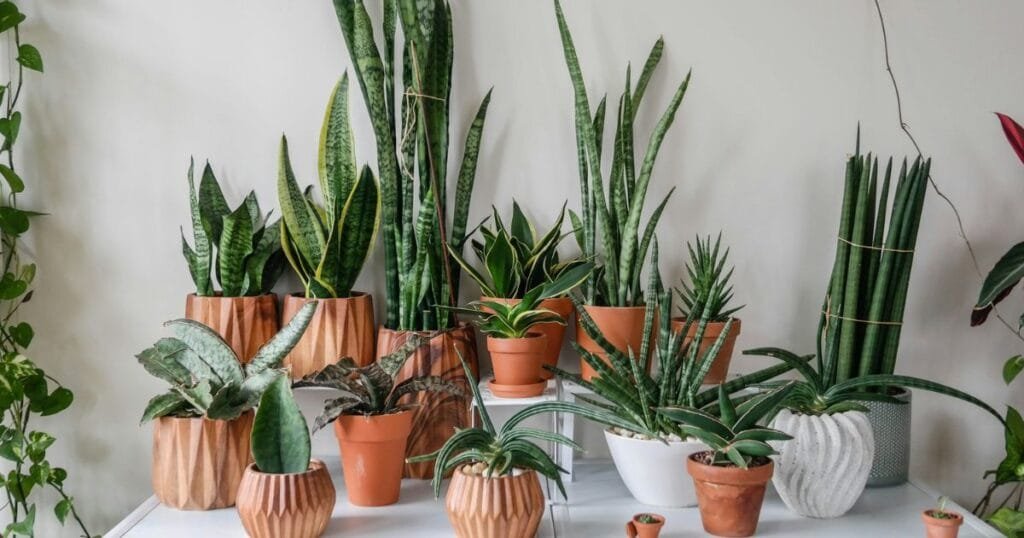
The Snake Plant is one of the easiest houseplants to care for. With its tall, stiff, sword-shaped leaves, it is also very stylish! Whether you are a beginner or an experienced plant lover, this guide will help you learn everything about caring of a Snake Plant. The best part? It only needs a little attention to thrive! Let’s dive into the simple steps to keep your Snake Plant happy and healthy.
Caring of Snake Plant by Watering
One of the most important things to know is how to water a Snake Plant. Unlike many other plants, the Snake Plant does not need much water. Too much water can hurt it! Check the wise consideration on water given below:
How Often to Water?
Water your Snake Plant only when the soil is completely dry. This usually means watering it once every 2-3 weeks. In winter, you can wait even longer—up to a month.
How to Water Properly?
Pour water into the soil until it feels moist but not soggy. Always make sure that the pot has drainage holes. Too much water sitting in the pot can cause the roots to rot, which is very bad for the plant.
Signs of Overwatering
If the leaves start turning yellow or soft, it means you are giving it too much water. Let the soil dry out before watering again.
Light Requirements for Snake Plant
The Snake Plant is very adaptable when it comes to light. It can survive in many different conditions, but it has some preferences such as:
- Best Light For the Snake Plant: It loves bright, indirect sunlight. A spot near a window where it gets some light but not direct sun is perfect.
- Can Snake Plant Live in Low Light? Yes! The Snake Plant can survive in low light, making it a great plant for darker corners of your home or office. However, it might grow slower in low light.
- What Happens With Too Much Sun? If placed in direct sunlight for too long, the leaves may get sunburned. You might notice brown or white spots on the leaves, which is a sign to move it to a less sunny place.
Caring of Snake Plant: Soil and Potting
The type of soil and pot you use also matters a lot for your Snake Plant’s health.
- Best Soil: The Snake Plant prefers well-draining soil. Cactus or succulent soil works perfectly because it doesn’t hold too much water. You can also add sand or perlite to regular potting soil to make it drain better.
- Choosing the Right Pot: Pick a pot with drainage holes so water can flow out. This prevents the soil from getting too wet, which helps avoid root rot.
- When to Repot: Snake Plants grow slowly, so you won’t need to repot often. Usually, you should report every 2-3 years, or if you see the roots coming out of the bottom of the pot.
Temperature and Humidity Required for Snake Plant
Snake Plants are pretty tough when it comes to temperature, but there are still some things to keep in mind.
Ideal temperature
They do best in temperatures between 60°F to 85°F (15°C to 29°C). They can handle cooler temps, but they don’t like anything below 50°F (10°C). Avoid putting them in drafty areas like near a door or window during winter.
Humidity
Snake Plants are used to dry conditions, so they don’t need high humidity. Normal indoor humidity works fine for them. Just avoid placing them in very humid rooms, like a bathroom, for too long.
Fertilizing the Snake Plant
Snake Plants don’t need a lot of fertilizer, but giving them a little boost now and then helps them grow strong.
- How Often to Fertilize? You only need to fertilize during the growing season (spring and summer), about once every 1-2 months. In fall and winter, you don’t need to fertilize at all because the plant is resting.
- Best Type of Fertilizer: Use a balanced liquid fertilizer that’s made for houseplants. Dilute it with water, so it’s not too strong.
Pruning the Snake Plant
Pruning is not something you will need to do often, but it can help your plant stay healthy.
- When to Prune: You should prune your Snake Plant when you see old, damaged, or yellow leaves. Use clean, sharp scissors or pruning shears to cut the leaves off at the base.
- Why Prune? Pruning helps the plant focus its energy on growing new, healthy leaves. It also makes the plant look neater.
Conclusion
The Snake Plant is one of the best plants for beginners and busy people. Caring of Snake Plant is easy and perfect for beginners. With its low-maintenance care needs and ability to thrive in various conditions, it is a perfect choice for any home. Just remember to water it when the soil is dry, keep it out of direct sunlight, and enjoy the fresh air it helps create!
FAQs
How often should I water my Snake Plant?
Only water it when the soil is dry. This is usually once every 2-3 weeks.
Can my Snake Plant grow in low light?
Yes! Snake Plants can live in low light, but they grow faster in bright, indirect light.
What type of soil is best for Snake Plants?
Use well-draining soil, like cactus or succulent soil, so water doesn’t stay in the pot.
Do Snake Plants need fertilizer?
They don’t need much. Use a little fertilizer during spring and summer for best growth.
Why are my Snake Plant’s leaves turning yellow?
Yellow leaves often mean too much water. Let the soil dry out before watering again.













